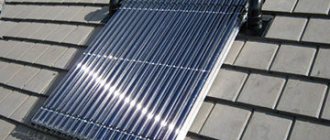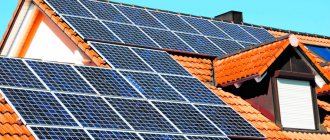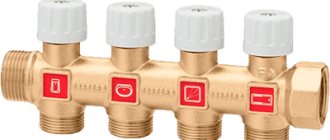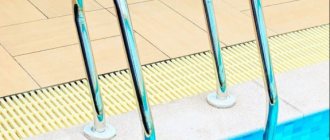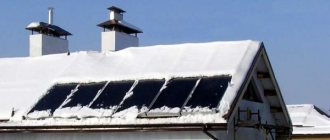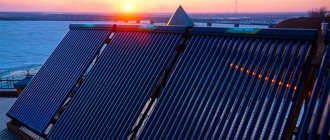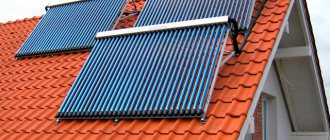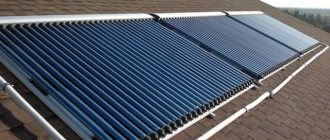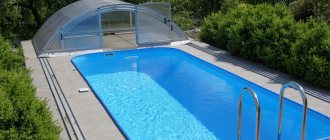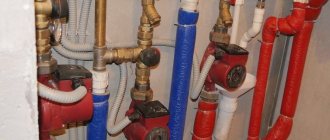Varieties
There are two types of solar collectors:
Open. Heat is accumulated in a hose laid in a spiral and fixed to the base.
The structure is not covered with glass. Such collectors function effectively only in hot weather and are designed for heating water in small pools.- Closed. Glass is fixed on top of the heat exchanger, which reduces heat loss. Such collectors operate all year round in clear sunny weather.
Solar collectors also differ in the type of storage element. To heat the water in the pool use:
- Vacuum (tubular) collectors.
This is a system of glass flasks with double walls - the vacuum between them provides reliable thermal insulation. Inside the flasks there are copper heat tubes with a low-boiling liquid. This liquid turns into steam under the influence of direct and diffuse sunlight, infrared radiation, and transfers heat to the coolant in the heating circuit. Vacuum collectors operate in cloudy weather and in winter frosts down to -40°C. This is the best option for an indoor pool for year-round use. - Panel. The heat absorber is a metal plate with a selective coating. The design of the collector also includes a box made of aluminum profile, a heat exchanger made of copper or aluminum pipe and protective impact-resistant glass. Such a solar system is all-season, but the efficiency of panel collectors is high only in warm sunny weather.
- Pyramidal. A dome-shaped frame is attached to the reflector, which serves as a support for a hose with a diameter of 25-40 mm, laid in coils. The top of the structure can be covered with glass to reduce heat loss. On a sunny summer day, a compact collector will increase the water temperature in a small pool to 23-25°C.
- Flexible. These are open type collectors, without protective glass. The heat absorber is a black plastic or rubber mat, inside of which there are channels with circulating coolant. The flexible collector is mobile; it can be laid out on the ground or on the roof of a building.
Instructions for making a solar battery with your own hands
There are many options for solar collectors. To heat water in outdoor pools at your dacha without large financial costs, you can make a solar collector yourself with your own hands.
A simple diagram of a watering hose
- On a metal sheet 1500x1500x2 mm. Black paint is applied.
- The watering hose is rolled into a spiral. It is necessary to create 4 snails of 60 cm in diameter connected to each other in series.
- The spirals can be secured to each other using wire or twine.
- They are laid on the plane of the sheet.
- Water is supplied from the pool through a circulation pump.
- The pressure is adjusted experimentally.
- The sheet must be raised to create an angle of 60 degrees. This is the necessary value for direct sunlight to hit the collector.
- The water in such a system warms up to 500C.
- Within a few hours, the water in the small pool will reach a comfortable temperature.
A more complex option for assembling a manifold from a plastic pipe
- Black paint is applied to the plywood sheet on the working side.
- A system in the form of a coil is soldered from a polypropylene pipe with a diameter of 10 mm.
- The pipe sections are connected by corners.
- The pitch between straight pipe sections is 50 mm.
- The structure is attached to a sheet of plywood using self-tightening polyethylene clamps.
- The pipe is painted black. This is necessary not only to heat the water, but also to protect the pipeline material from the destructive effects of ultraviolet radiation.
- The finished block is framed with a frame made of 20x20 mm slats.
Strips of glass are attached to the top of the frame. They will ensure better heating of the pipe by creating a barrier for protection from wind and accumulating additional volume of sunlight.
- The rear wall of the collector is covered with foam plastic to create thermal insulation of the internal space.
- To install the structure, a frame is assembled from timber with a section of 50x50 mm.
- The collector is mounted rigidly on the frame to resist wind.
- Water is supplied from the bottom edge using a circulation pump.
- The water outlet is in the upper corner of the opposite side of the system.
- When the pump is properly adjusted, the water temperature reaches 650C.
- Hot water flows through a hose into the pool.
Design and principle of operation
A solar system for heating a pool, regardless of type, consists of the following elements:
- absorber (absorber) of solar energy;
- connecting hoses;
- circulation pump;
- filters for purifying water entering the collector circuit;
- water supply and drainage valves.
The system operates as follows:
- The absorber collects thermal energy and heats the water in the collector circuit.
- Heated water is discharged into the pool when a valve with a temperature sensor is activated if the water temperature in the bowl is below a set value.
- Water from the pool is pumped into the circuit by a circulation pump (passes through the filter).
The working process
A solar collector for heating water for a swimming pool is constructed as follows:
- We lay the coil on the prepared site. To do this, we cut the timber and connect it with clamps and self-tapping screws;
- the resulting structure should be sheathed with plywood;
- after that we build the frame;
Note! Since the weight of the device will reach up to 30 kg, the entire frame should be made durable and able to easily withstand such a weight. Here you need to take into account the weight of glass, snow, water, the impact of wind on the structure, etc.
Frame for water heater
- after that we assemble the frame. It should be strengthened with anchors. With the help of such fasteners we secure the transverse bars to the frame. The frame is assembled according to the scheme that you have chosen for your solar water heater. The quality of water heating will not depend on the type of circuit;
- when the frame has been removed, the entire platform (and frame) should be painted black;
- We fix the platform to the frame using anchors. In this case, it is imperative to maintain the angle of inclination;
- Next, we mark the platform at the places where the pipes are installed. Here we install plastic fasteners. All structural elements must be painted black.
Note! For ease of painting, it is good to use a can of black paint or a spray bottle.
Installed platform with fastenings
After this, we connect the pump to the assembled structure. Here you need to choose a not very powerful pumping unit. This is due to the fact that water through the pipes must flow slowly in order to have time to warm up thoroughly. In this case, the pipes must lead directly into the pool. They should come out from the bottom of the pool. In order to avoid heat loss, it is necessary to install protective glass. A glass thickness of at least 4 mm is suitable. After this, we make a test connection to check the success and quality of the prefabricated solar panel structure for heating the water in the pool.
Finished water heater
Such a homemade unit using solar energy will cost you quite cheap. It can be successfully used to heat water during the entire warm period. When cold weather sets in, all water should be drained from the solar water heater unit to prevent it from freezing inside the pipes. If this is not done, the structural elements may be damaged, and you will no longer be able to use it next year.
Advantages and disadvantages of heating water using a solar system
The advantages of solar collectors for swimming pools include:
- Affordable cost of some types of systems. With their help, you can heat the water in the pool to comfortable values without significant financial costs.
- Simple installation, low maintenance.
- The ability to easily increase the heat transfer of the installation using several panels. Relevant for large pools.
- Simple design - you can make a solar system yourself.
- Possibility to expand the boundaries of the swimming season for outdoor pools and use the indoor pool year-round.
- Environmental friendliness and durability of the system.
The list of disadvantages of solar systems includes:
- dependence of inexpensive installations on climatic and weather conditions;
- power requirement for the circulation pump.
Homemade solar collector
- The first step is to build the frame. It must be strong to support the weight of the canvas. The beams are fastened with furniture corners. It is advisable to do it in such a way that the canvas can tilt at different angles. Depending on the incidence of sunlight. Then heating the pool from solar panels will be faster and more efficient.
- A canvas is constructed from beams. The canvas is a square or rectangle. This is an important and basic part of the design. The canvas consists of durable chipboard, to which a sheet of tin is attached. The tin is coated with matte black paint. Black color warms up better. If the collector will be used only in summer, then additional insulation is not needed. A box and glass will be enough. If solar heating of the pool will be carried out in the cool season, then it is worth laying insulation on top of the coil.
- It is better to make the coil from copper tubes. Tin warms up faster. The finished soldered coil is also painted with black paint and looks like a black hose. The holders for it are attached to the canvas at the same distance. Moreover, the coil should be 15 cm smaller than the canvas itself on each side. On the contrary, the output tubes are larger. In the future, water hoses will be connected to them.
- Also, we must not forget that the solar collector for the pool must be equipped with automatic valves that will release the resulting water vapor from the hot water.
- The box is well coated with sealant so that there is practically no air.
- Cover with glass.
- Connect hoses to the water inlet and outlet.
- The collector is installed near the pool on a flat surface. The main condition is that the area under the collector is illuminated for as long as possible. And there was no shadow from buildings or trees.
The solar collector for heating the water in the pool is ready. And its construction will require little time and expense. It will pay for itself in the first year. Especially good for places where there are frequent power outages. This collector can be used to heat not only the water in the pool, but also the shower.
The solar collector can be purchased at a specialized store. Even though the price is quite high, it justifies it. Since when installing such a collector on the roof or ground of your site, you:
- The heater will heat water not only in the pool, but also for showering, washing dishes, and watering in the greenhouse.
- The steam from the hot water will be used to heat the house. Will reduce the cost of an electric boiler and the load on it.
- The service life of the solar battery is 20 years.
- The coolant heats the water and supplies it to a storage tank that the whole family can use.
- Beautiful appearance.
Battery selection principles
The choice of solar collector primarily depends on the type of pool (outdoor or indoor) and the seasonality of its use.
Pyramidal and flexible - an inexpensive and practical option for an outdoor summer pool. If you cover the bowl with an awning at night, you can significantly reduce heat loss and speed up the daytime heating of water to comfortable temperatures.
A panel solar system will help start and end the swimming season earlier and later in an outdoor and indoor pool. But in the cold season, its efficiency decreases noticeably.
Vacuum is the best choice for an indoor pool. In the warm season, the system will maintain the required water temperature in the bowl, and in winter it will reduce the total heat consumption for heating the pool by 30-40%.
When choosing a collector, it is important to correctly calculate its power and total area. This takes into account:
- pool type (outdoor/indoor);
- collector type and seasonality of use;
- place for placement (an open area next to the tank, the roof of a terrace or other building), the location of the panel relative to the sun, the angle of inclination;
- optimal water temperature in the tank.
The panel area is calculated individually. In general, for a closed artificial reservoir this figure should be 50-70% of the bowl’s area, for an open one - 70-100%. The power of the circulation pump is selected based on operating parameters and the number of heaters in the solar system.
Let's talk about the collector
Solar collector or water heater is widely used today to heat water. In addition, they can also be used to heat houses. A special feature of such water heaters and collectors is that they use solar energy in their operation. This type of device is quite expensive, so many today are asking the question: “how to make it with your own hands to heat water?” Well, let's try to figure this issue out. We will start by finding out what designs of such devices exist at the moment. The design options for a solar collector for heating water differ from each other:
- cost of components;
- a list of materials and their quantity required to assemble the device with your own hands;
- assembly technologies.
Note! Each type of solar collector design works on the same principle, although different materials will be needed to assemble them.
Collector design option
By approaching the work correctly, you can build a solar water heater with your own hands, spending a minimum of money on it and using available materials. At the same time, many homemade solar collectors used for heating water do not differ in their technical characteristics from factory models, and sometimes even surpass them.
Models on the market, prices
Manufacturers of inflatable and frame pools produce a wide range of equipment and accessories for them, including devices for heating water using solar energy.
Intex Solar Mat
Flexible mat Solar Mat (28685) 120x120 cm for holding tanks with a filtration system . The circulation pump model is selected based on the number of mats in the solar system (from 1 to 5). Flexible manifold price: from 1800 rub.
Bestway
Flexible mat (art. 58423) 110-171 cm made of polyvinyl chloride. Connects to a cartridge or sand filter-pump of the pool. The heating area is 1.46 m2. Price: from 5000 rub.
Poolmagic
The range of heaters includes:
- Panel SP06305 (32396) . Flexible mat 305x60 cm made of polymer material. Price: from 7500 rub.
- Spiral 1500 (32394) . Pyramid heater made of polypropylene with a protective dome and base made of UV-stabilized polycarbonate. The diameter of the dome base is 58 cm. Price: from 8800 rubles.
- Poolmagic SSR (32308) . Pyramid model with a diameter of 59 cm and a height of 28 cm. Made of PVC, a protective transparent cover is provided. Price: from 12500 rub.
- Curve 3900 (32395) . Heater in the form of a rigid curved panel 110x69 cm on a support. It functions similarly to a mat, is made of HDPE and has a polycarbonate lid. Price: from 11,000 rub.
Azuro
The manufacturer produces flexible mats of different sizes:
- 300x120 cm (3EXX0162),
- 450x120 cm (3EXX0161),
- 300x60 cm (3EXX0159) and 600x60 cm (3EXX0158).
The price depends on the dimensions, the presence of a support and shut-off valve in the kit and ranges from 16,000 to 49,000 rubles.
Also:
- Shelter (3EXX0165) . A flexible mat 120x90 cm is installed on a support in the form of an arch. Price: from 15,000 rub.
- LUX 800 Supreme (3EXX0259) . Rigid curved panel 119x76 cm made of polymer material with protective glass and support. Price: from 14,000 rub.
- Pyramid Spiral (3EXX0052) . A pyramidal model with a base of 120x80 cm and a height of 40 cm, equipped with a protective dome made of polycarbonate. The cascade can include up to 4 heaters. Price: from 29,000 rub.
Kokido
Pyramid solar heaters from Kokido with a protective transparent dome Keops (K835CBX) (57x57x32 cm) and Keops II (K849WBX) (81x81x42 cm). The solar system can include up to 4 heaters. Price: from 11,000 rub.
Sunheater
Flexible solar heater from Sunheater (art. 30065) made of polymer material 600x60 mm. Price: from 18,000 rub.
Solar Heater
Solar collectors, also called solar systems, differ in the type of construction. They are tubular, panel, pyramidal and flexible. The operating principle of all types is based on the ability to accumulate solar energy and transfer heat to the carrier. Tubular and panel ones operate year-round. And with the help of flexible and pyramidal ones it is easy to heat the water in the pool in the summer.
Tubular heaters consist of hollow glass flasks, a copper rod and a prefabricated distributor that directs the heated coolant into the pool bowl. These are vacuum-type collectors that are used in outdoor pools from April to October.
A panel solar collector is a metal box with a top panel made of thick glass. The storage element is a metal plate with a special coating that has absorbing properties. The heat exchanger looks like tubes made of copper and aluminum. The flat panel heater is effective in sunny weather.
Pyramid installations are capable of heating water in an outdoor pool to 23°-25°. The role of a solar energy absorber is played by hoses that are twisted in a spiral over the reflector. Water is supplied to the system and pumped back by force.
The flexible manifold looks like a rubber mat. There can be from 1 to 6 sections. They are easy to fold and transport. Selected according to pool size.
Advantages of organizing heating for a pool using solar energy:
- water heats up quickly in sunny weather;
- no maintenance costs;
- no fuel required;
- safety for humans and the environment.
Minuses:
- weather dependent.
Can I do it myself?
It is quite possible to assemble a pyramidal heater on your own . This will cost 2-3 times less than purchasing a similar model.
At the preliminary stage, the length of the pipe is calculated. With a diameter of 25 mm, one meter of pipe on a sunny day can heat up to 3.5 liters of water per hour. The pump is selected based on the fact that the coolant speed in the system should be 0.4-0.7 m/s.
Work progress:
- A frame in the form of a pyramid/herringbone is made of metal or wood.
- A black HDPE pipe laid in turns is attached to the frame with clamps (the pitch of the turns is 1-1.5 cm).
- Hoses are attached to the resulting equipment.
It is recommended to cover the structure with a pyramidal lid made of glass or UV-protected polycarbonate. The lid reduces heat loss and creates a greenhouse effect, accelerating the heating of water.
Connection and operation
Installation of vacuum and panel solar systems requires the involvement of professionals. Household heaters, flexible or pyramidal, can be connected to the pool yourself.
Work progress:
A flexible mat is spread on the ground or roof; a polymer solar heater in a more rigid design is mounted on a special support.
The pyramidal collector is installed on a bed of reflective material.- The solar collector is connected with a hose to a supply filter pump, which pumps water from the pool into the system.
- The return hose connects the manifold directly to the pool - the heated water is drained directly into the tank.
The solar collector should be assembled according to the manufacturer's instructions.
Operating rules:
- the protective glass of the solar collector should be regularly cleaned of dust - contamination significantly reduces the efficiency of the heater;
- When the temperature drops to near zero, water should be drained from the outdoor pool collector to avoid freezing of the system.
User reviews
Users note that solar heaters made of polymer materials can increase the temperature of the water in the tank in a few hours only on clear, hot days.
In cloudy weather, efficiency is significantly reduced . Experience shows that it is worth minimizing heat loss due to evaporation by covering the bowl of an outdoor pool with a special blanket.
Users in regions with cold climates and few sunny days have highly appreciated the effectiveness of vacuum solar heaters, which receive thermal energy not only from the sun's rays, but also from infrared radiation, which is also present in cloudy weather.
In the summer, consumers had to resolve the issue of draining hot water after heating the pool to a comfortable temperature. Reviews can be found here and here, here and here.
Device
Construction of a solar collector An excellent solution for a swimming pool is a solar collector that collects thermal energy transferred by the sun.
Unlike solar panels that create electricity, the collector heats the coolant material. In most cases, the solar collector is used as a heating and water supply device. There are several types of collectors: vacuum and flat.
The vacuum tube is the heart of the collector, responsible for absorbing light and subsequently converting it into heat.
The tube consists of two glass tubes, one of which is inserted into the other. Their ends are sealed, and the air is pumped out from inside. The inner tube is black, allowing the tube to absorb light.
The glass is made from special borosilicate. This material is used in the manufacture of kitchen hobs. The material has high viscosity and is quite resistant to cracks.
The tubes are protected from damage and are manufactured with a standard thickness (1.8 mm).
Heat pipe – transfers heat upward to the collector.
Heat pipe
The collector is a completely insulated box with a collector tube located in it. The collector is responsible for removing heat from the tubes.
The body is made of aluminum, which makes installation easy. It is completely sealed and does not allow moisture to pass through.
Mineral wool serves as insulation and thermal insulation inside.
The mounting frame is usually made of stainless steel or aluminum, depending on the installation location and weather conditions. All parts of the device are located on the frame.
Let's consider the device of a flat collector:
- protective glass;
- absorbent surface;
- thermal insulation;
- coolant;
- copper tubes;
- aluminum frame;
How to heat a tank without electricity?
To heat water in a tank without using electricity, you can use:
- Heat exchanger. The heating of the water entering the bowl is carried out by a circuit with a hot coolant. This is usually a circuit of the heating system, so this option is suitable for indoor pools during the cold season.
- Non-volatile boiler - solid fuel, gas or liquid fuel.
Please note: a heat pump, like a solar system, consumes electricity.
Features of work
When installing a solar collector for heating water in a pool with your own hands, you first need to understand the features of these structures. They differ in cost, materials, and technologies used during assembly.
If you correctly and carefully approach the assembly of a solar collector with your own hands for heating water in a swimming pool, then it will not be inferior in quality and technical characteristics to its professional, industrial counterparts and in some cases will exceed these characteristics.
Despite the difference in materials for mounting solar collectors, the principle and operating features of these structures are similar.
Vacuum
To achieve greater efficiency, the device must be installed on the roof. The collecting abilities of the collector do not depend on weather and air temperature. The device can be mounted at any angle, ranging from 5 to 90 degrees.
The device's vacuum tubes capture solar energy. Passing through a transparent outer tube, the energy is retained in the second flask with an absorbent applied to it.
Thus, the absorbent is heated to a certain temperature and penetrates through the second flask onto the heat pipe, and the heated ether, turned into steam, passes into the working part of the heat pipe. Having given off heat, the steam turns into condensate and returns back to the bottom of the tube, then the cycle repeats.
Flat
The operation of a flat-plate collector is based on the greenhouse effect. The sun's radiation is almost completely absorbed by the outer glass, and approximately 90% of the energy reaches the internal absorber. When heated, the coating begins to radiate thermal energy.
The transfer of accumulated energy to the heat carrier is carried out using copper or aluminum elements.
The heating system for the pool can be either autonomous or connected to the heating system of the house. Joint heating with the cottage is very convenient and economical. But it’s worth thinking about this at the construction stage.
The collector is a canvas with many metal tubes within which water circulates. The water is heated by sunlight and is pumped into the reservoir. This is how solar heating of the pool water occurs. Let's look at how to build it to heat water with your own hands.
For the design you will need:
- Beams, slats, furniture corners, screws, nails for fastening them.
- Chipboard sheet.
- Sheet of tin.
- Black paint.
- Metal or plastic tubes, adapters and holders for them.
- Hoses for supplying water to the coil and discharging heated water into the pool.
- A pump for circulating water through the coil.
- Double-glazed window or glass.
- Thick insulation.
